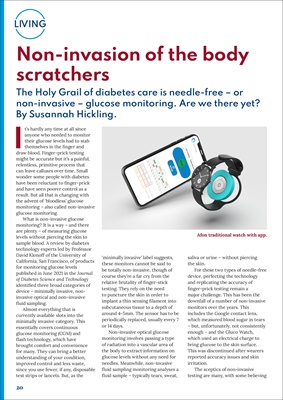
20
LIVING
Steve adds: "Neither of us knew
about diabetes, in any form. We
had heard of it, but that was about
it. Hugo had always been a slender
child, so we put this down to him
being active and sporty and the thirst
down to it being a hot summer. The
diagnosis was a shock but we quickly
got on the case - we weren't going to
take it lying down! We're constantly
looking at what is out there, asking
if we should be looking at smart
pens, looking at different sensors
and more."
While technology plays an
important part in the management
of Hugo's Type 1, Steve and Sally
believe in the power of research to
bring about better treatments, and
eventually a cure.
Steve and Sally were introduced
to JDRF and the world of type 1
research when Hugo was being
cared for by the Countess of Chester
Hospital. Sally explains: "Hugo was
given a KIDSAC that contained
Rufus the bear. That bear helped
us all a lot, especially Hugo, who
gave a short tutorial to his fellow
classmates about diabetes. The pack
was so useful that we looked JDRF
up and then, 12 months after Hugo's
diagnosis, we approached the charity
about making a donation."
Steve and Sally have a long history
of philanthropic giving. In 2001
Steve founded the Steve Morgan
Foundation to support projects
that help children and families,
people with physical or learning
disabilities, the elderly, or those that
are socially disadvantaged in North
Wales, Merseyside and Cheshire.
Since its launch, the Foundation
has committed assets of £300m to
charities and supported over 2,000
grants, which have benefitted more
than three million people.
"Four years ago, we donated £3m
to JDRF," says Steve. "I wanted it to go
directly into research. We followed
through with subsequent grants.
We've never, ever just sat back and
written cheques. We don't want what
we donate to end up being swallowed
up by the administration costs, we
want it to go directly to where it's
needed. In this case to finding a cure
for Type I diabetes."
The latest donation of £50m will
be directed into three main avenues
of research. Over the next five
years the partnership will challenge
scientists to come up with pioneering
There's so much to
do, to remember,
to consider and
even carry about
with you.
~ Sally Morgan
research ideas focussing on new
insulins, treatments to stop the
immune system's attack on insulinmaking beta
cells and treatments to
rescue and replace beta cells.
"When we told Hugo about the
£50m donation, he just burst into
tears and gave Steve a huge hug,"
says Sally. "It showed the size of what
he has to deal with on a day-to-day
basis due to his type 1 diabetes."
The scale of the donation and
ambitions of the Type 1 Diabetes
Grand Challenge will allow the
partnership to make bigger strides
forward in the search for more
effective treatments and eventually
a cure, giving everyone with type
1 hope that in the future type 1
diabetes won't be the continuous
burden that it currently is.
"It would be in our wildest dreams
to get a cure at the end of these
five years," says Steve. "It's probably
unlikely, but what it will do is bring
forward the day when we get a cure."
www.diabetes.org.uk/
grandchallenge
www.jdrf.org.uk/race-for-a-cure
www.stevemorganfoundation.
org.uk
Hugo Morgan in JDRF t-shirt.